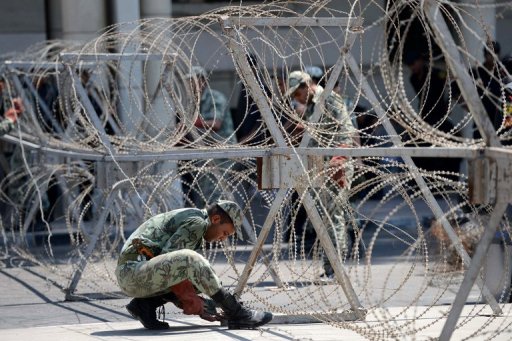Last month, The Guardian posed this question; is “Gomorra the best mafia film of all time? The colossal buzz generated by its Grand Prize win at the Cannes Film Festival last May was translated into massive box-office gains to become, in a span of a few weeks, Italy’s highest grossing film of the year.
In recent weeks, the Italian mafia declared it wanted Roberto Saviano, young author of the multi-million selling non-fiction book of the same name, dead by the end of the year. By the time the film reached the UK last month, the frenzy over “Gomorra reached its peak, cultivated further by the unanimous glowing reviews and a solid box-office take. Last week, the film was nominated for five European Film Awards, including Best Film and Best Direction.
“Gomorra stands today as the most successful Italian production since Roberto Benigni’s 1997 overrated comedy “Life is Beautiful before it even opened in North America. “Gomorra has turned into a phenomenon, ushering a new golden age for the withering Italian cinema.
Egyptian filmgoers can brace themselves; the good people of the Cairo Film Festival have managed to bring “Gomorra to Cairo in perhaps an attempt to distract festival-goers from the notable lack of high-profiled foreign art-house hits.
Having watched “Gomorra twice so far, I can attest that it’s not the best mafia film of all time. “Gomorra though is a real masterpiece; an uncharacteristic, slow-moving and harrowing mafia film bound to disappoint viewers expecting the bombast and panache of mob operas “The Godfather, “Goodfellas or “Scarface.
For starters, the film lacks a central charismatic, flamboyant figure à la Don Corleone and Tony Montana. There are no sympathetic outlaws in “Gomorra, no Robin Hood-like figures. Unlike standard mafia/crime films, “Gomorra doesn’t unfold in a Greek tragedy.
Instead, Naples-based filmmaker Matteo Garrone opts for an ultra realistic approach, weaving his multilayered narrative on five different characters, all inhabitants of Naples’ slums that are entirely controlled by the Neapolitan mob known as camorra, whose storylines never intersect. The majority of actors are amateurs, some of whom are actual residents of the area.
A new order is about to hit Naples’ suburbs as a new gang attempts to overthrow the reigning one. The repercussions of the turf war are employed to explore the stark reality of Naples, a city corrupted to the core where lawful authority is almost non-existent and the Catholic Church is absent.
Marco (Marco Macor) and Piselli (Ciro Petrone) are two strident, imprudent teenagers obsessed with Tony Montana. The two misguidedly assume they can stand up to the camorra bosses and operate their own business after stealing a stash of cocaine.
Don Ciro (Gianfelice Imparato) is a careworn middle-aged accountant employed by the old gang to keep track of the pensioners and their families who get caught in the middle of the escalating war.
Young kid Totò (Salvatore Abruzzese) tries to join the old gang, contenting himself meanwhile with delivering groceries to a woman that occasionally stands for a missing mother figure.
Pasquale (Salvatore Cantalupo) is a professional camorra tailor, whose decision to accept working for the competitors’ Chinese-sweatshops doesn’t bode well with his bosses. The last episode centers on young college graduate Roberto (Carmine Paternoster) who snatches a job with respected-looking businessman Franco (Toni Servillo) who orchestrates the dumping of EU’s toxic wastes into the city.
The war itself is as predictable as any other ordinary business. The most striking aspect of the film though is how helpless nearly every citizen of the city seems to be.
Simply put, there’s no way out for these characters, no alternative path of life. Unlike the glamorized world of “The Godfather and its ilk, friendship and honor are hazy, improbable ideals neither the rich nor the poor can afford to adhere to in Naples. Alliances are bound to be broken. The lives of the suburbs’ forgotten inhabitants are at stake every day. Deaths occasionally occur for no palpable reason.
Garrone allows this reality to gradually unfold from the details of the district’s everyday life. The average chills of crime films are nowhere to be found in here.
Garrone, whose equally masterful “The Embalmer (2002) was also set in Naples, assumes the role of passive observer; watching his characters from afar, refusing to submit to easy characterization.
As innovative and sophisticated as his approach is, the average viewer may find it challenging. “Gomorra is not the type of film where you can emotionally invest in the characters. Because of the stern moral ambiguity of Garrone’s world, it might be difficult to sympathize with flawed characters, who make ethically questionable choices under circumstances few can imagine.
Garrone focuses his lens on the heart of a powerful social and economic system. What he doesn’t do though is illustrate how these atrocities affect the entire city or the country as a whole. Apart from one scene where Don Ciro recognizes actress Scarlett Johansson’s dress that looks too familiar to his own designs, Garrone doesn’t point up how the camorra penetrates the entire Italian system and beyond (in the book, Saviano draws certain connections between the camorra and the UK).
Ironically, a minister of the Berlusconi cabinet is currently under investigation for collaborating with the mob boss who sent Saviano the death threats.
I left “Gomorra disturbed and unsettled. The facts displayed at the end of the film are even more shocking. Although Garrone coyly avoids putting forward a broad commentary on the Italian political system, it’s almost impossible not to feel disdainful for the impotency of the country’s political structure that hasn’t changed much for more than three decades now.
There are no instant gratifications in “Gomorra and the film doesn’t seek to entertain the same way Hollywood or even popular European art-house films do. It is a triumph in filmmaking, infusing a few extraordinary surrealistic images with the dominant realism in a fashion that’s quintessentially Italian. A hallmark in the rising Italian cinema, the film is indeed one of the best of the year.
